The divine Devil's Lake
In Wisconsin's Baraboo Hills, a stunning state park makes people come running.
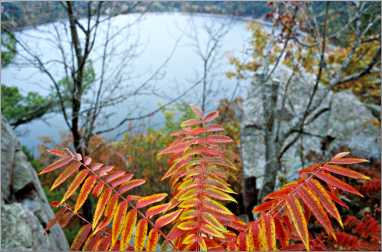
© Beth Gauper
In Wisconsin, a bunch of rocks sets hearts aflutter.
They enchant geologists, of course, but also scuba divers, rock climbers and botanists. The rest of us, too — hikers, birders, campers, Boy Scouts.
We all go to give Devil's Lake its due.
Just south of the Wisconsin Dells, Devil's Lake State Park draws more than 3 million people a year, four times as many as Minnesota's most-visited state park, Gooseberry Falls.
Its lake is one of the clearest. Its glassy-smooth quartzite cliffs are the most challenging to climb. Its flora is among the rarest. And its rocks tell a story that's as clearly drawn as a first-grade primer.
It's all there, in 500-foot bluffs that crumpled 1½ billion years ago in a collision of continents. It's in pockmarks that show where 50-foot waves smacked rock against rock 500 million years ago.
Volcanoes, tropical oceans and glaciers all left visible mementos of their stays.
Spectacular as the geological story is, the fall leaves stole the show one October, when I visited with friends. We'd driven only a few feet into the park before we had to get out and gaze, awestruck, at a canopy of golden sugar maples that made the air shimmer with light.
"It's like in the 'Wizard of Oz,' where Dorothy wakes up and sees the Emerald City, and suddenly everything is in color," said my friend Mary.
It was the third weekend of October, late for such a vivid display of fall color, but this part of Wisconsin follows its own rules.
The surrounding Baraboo Hills are an ecological crossroads that was one of the first "Last Great Places" named by the Nature Conservancy.
From its 30-mile-long flanks radiate the coulees of the Driftless Area, the central sand plains and the lumpy rubble left by the Wisconsin Glacier, which covered two-thirds of North America but was named for Wisconsin because that's where its path can be traced best.
Once we got past the entrance, we drove down to Devil's Lake. Its name is thought to be either a reference to its otherworldly rock formations or a mistranslation of the original Ho-Chunk name or a clever bid to attract tourists.
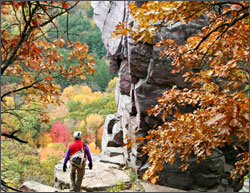
© Beth Gauper
It was a resort area until 1904, with guests arriving on a rail line that still hugs the east shore.
The state park was established only seven years later, but three private cottages still occupy a corner of the west shore.
With a trail map in hand, we set off on the West Bluff Trail, also part of the Ice Age National Scenic Trail. It took us high above the lake, where we stood on flat slabs of slick pink quartzite admiring the view over clumps of cedar, juniper and sumac.
On many of the slabs, we could see ripple marks left by waves 2 billion years ago, when the quartzite was sand at the edge of an iron-rich ocean.
"Ooh, I can feel it," said my friend Val, laying her hands on the wavy ripples. "I'm trying to suppress that Julie Andrews 'The Hills Are Alive' thing."
It's easy to see why the Ho-Chunk and early European visitors might have thought supernatural forces were at work here.
Many of the cliffs look as carefully built as a retaining wall; on the other bluff, such formations as Balanced Rock and the Devil's Doorway look like nothing made by nature.
At one overlook, an exhibit explained an ancient river cut the canyon below but was plugged by debris carried by the last glacier, causing the rise of a spring-fed lake. The former riverway still can be seen plainly, stretching into the horizon.
Down at the lake, we walked back along the Tumbled Rocks Trail, which dodged between hundreds of gigantic quartzite blocks that frost had split from the bluffs.
"This has just been eye candy," Val said when we got back.
Mementos of the Ice Age
The next day, we split into two groups so we could hike the 10 miles between Devil's Lake and Parfrey's Glen.
My group started on the East Bluff Trail, from which we could see the Baraboo Hills undulating to the north; as we looked, the sun came out and made all the yellows pop out of the treetop quilt of colors.
Across the lake, the field of 800-ton boulders we'd walked through the previous day looked like a slope of scree.
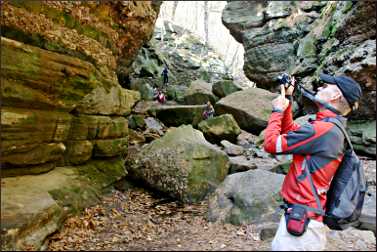
© Beth Gauper
Soon, we came to Balanced Rock, plunked on the edge of a cliff, and the Devil's Doorway, with an arch that seemed a little haphazard.
"It looks as if a kid put it together," Cathy said.
Then, we squeezed along narrow paths, picking our way carefully from slab to slab. "I feel like a Grand Canyon mule," Jane said.
We descended to an oak forest, but soon our path led us back up the rock bluff. By the time we'd scrambled our way up to the junction with the Ice Age National Scenic Trail, our knees had turned to jelly.
The 1,000-mile trail, which follows the farthest advance of the last glacier through Wisconsin, makes a big loop around Devil's Lake, forming two east-west segments.
From the southern stretch we used the state park's Upland Trail to connect with the northern stretch; just west of County Road 113, we met the other group and, after exchanging car keys, sat down for a picnic.
After lunch, my group continued eastward through a corridor of red and yellow maples and into meadows lined with scarlet sumac. It was easy walking, and soon we reached Parfrey's Glen, the state's oldest natural area.
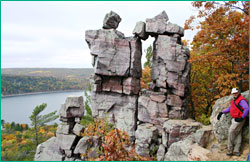
© Beth Gauper
From the parking lot, a path followed a trickling stream into a narrow slit in the Earth. Its walls were plum-puddingstone, globes of quartzite embedded in sandstone; at the back of the gorge, a lacy waterfall fell from a creek overhead.
Parfrey's Glen is the best known of the state's natural areas and one of the easiest to visit.
But the Baraboo Hills are sprinkled with these areas as well as Nature Conservancy preserves. The nonprofit group has been working to protect the range for more than 30 years and now owns nearly 8,000 acres at 12 preserves, which it keeps open to the public for low-impact recreation.
For some reason, their names have a hillbilly quality — Baxter's Hollow, Hemlock Draw, Pewits Nest.
The next day, we headed for Pewits Nest, a state-owned creek gorge that was named for "an individual who lived in the solid sandstone, like a gnome in a cavern . . . this dwelling resembled the nest of a phoebe (or peewit, an earlier name for this bird), hence dubbed by early settlers the 'Peewit's Nest.'"
It's surrounded by farm fields, but once we got there, we were in another world. From the top of the gorge, shaded by a canopy of cedar, pine, hemlock and birch, we followed a trail to a black pool whose surface was completely coated by a colorful mosaic of fallen leaves.
It was fed by a small waterfall, and we could see more whitewater farther down Skillet Creek, running between the moist, terraced walls of the gorge.
Nearby attractions
That appealing little pocket whetted our appetite for discovery, so we drove down U.S. 12 to the Land of Evermor, where salvager Tom Every turned spare parts into whimsical folk art, most famously the Forevertron, a time and intergalactic travel contraption that may be the world's largest scrap-metal sculpture.
In their own way, the recycled pieces were as beautiful as Pewits Nest, and Every, who died in 2020, considered himself as much a conservator as the folks at the DNR and Nature Conservancy.
"We're only here a short time," said Every, who started building his art park in 1983. "We've got to leave this planet something. We've got to leave it a little better than we found it."
In the Baraboo Hills, people preserve things. At the Mid-Continent Railway Museum in nearby North Freedom, you can ride on restored coaches behind old locomotives.
At Circus World Museum in Baraboo, you can see the world's largest collection of circus wagons at the old Ringlingville.
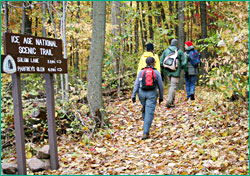
© Beth Gauper
And at the International Crane Foundation, you can see birds that nearly went extinct.
The crane haven was our last stop. It harbors all 15 of the world's crane species, because crane habitat is shrinking all over the world.
Its whooping cranes have their own marsh and exhibit, which tells how young Wisconsin cranes were taught to follow an ultralight to Florida in 2001, re-establishing the traditional winter migration and helping to build the flock.
In this part of the world, preservation has paid off for everybody.
Trip Tips: Devil's Lake State Park and Baraboo Hills
Getting there: It's 45 minutes north of Madison, just south of Wisconsin Dells off U.S. 12. The park is three miles south of Baraboo.
Admission: A daily vehicle permit is $13 for residents, $16 for non-residents, higher than other Wisconsin state parks. Devil's Lake also accepts national park passes.
People who also buy a daily permit at nearby Mirror Lake can visit both parks for the Mirror Lake rate of $8/$11.
Hiking: There are 30 miles of hikes of all lengths and difficulties in Devil's Lake State Park. On the west side of Devil's Lake, the paved Tumbled Rocks Trail is only a mile and follows the shoreline.
Atop the bluffs on the east side of the lake, the East Bluff Trail also is a mile. Both trails connect to the Ice Age National Scenic Trail.
A hike around Devil's Lake, including a loop around the Devil's Doorway and Balanced Rock formations on the southeast side of the lake, is about five miles.
To make a great 10-mile one-way hike, walk from the visitor center on the north shore (pick up a trail map) to the East Bluff Trail and follow it to the Balanced Rocks Trail. From it, take the Grottoes Trail mile to the CCC Trail.
At the top, look for a narrow path; it leads to the southern segment of Ice Age National Scenic Trail.
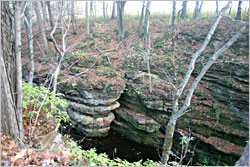
© Beth Gauper
Head east, following the yellow blazes, then take the Uplands Trail to the northern segment of the Ice Age Trail, which soon crosses County Road 113 as it heads east to Parfrey's Glen; it's another 1½ miles to the end of the canyon and back. Expect to spend at least 5½ hours.
For more about the geology, see High drama at Devil's Lake.
Camping: Devil's Lake State Park is the most-visited park in Wisconsin and extremely popular in summer; weekend reservations are snapped up as soon as they become available, 11 months in advance.
Parfrey's Glen: Take South Lake Road around the southern shore of Devil's Lake and turn south onto Wisconsin 113. Take the next left onto County Road DL and drive two miles. A park vehicle sticker is required.
Pewits Nest: This state natural area is small but lovely, especially in fall.
Due to overuse and abuse, part of Pewits Nest may be closed, and visitors are not allowed to climb around in the gorge.
From U.S. 12 south of Baraboo, head west on County Road W. It's 1½ miles to a small parking area. If you park elsewhere, you will get a ticket.
International Crane Foundation: It's three miles southeast of the junction of I-94 and U.S. 12.
For more, see Cranes of Wisconsin.
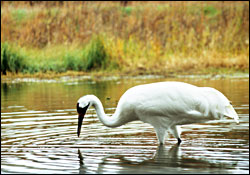
© Beth Gauper
For more on the crane foundation and the naturalists who came from the area, including John Muir and Aldo Leopold, see Pilgrimage to the Baraboo Hills.
Land of Evermor: It's seven miles south of Baraboo on U.S. 12, behind Delaney's Surplus and across from the old Badger Army Ammunition Plant. Check for times it's open.
Circus World Museum: Exhibit halls are open year-round. The circus performance season begins in mid-May and runs through Labor Day. It's open daily from mid-April to late October, weekdays in winter.
For more, see Baraboo's gilt complex.
Mid-Continent Railway Museum: Trains run daily through the summer and on autumn weekends; there's a snow train in February.
Accommodations: The Willowood Inn is closest to Devil's Lake, just south of Baraboo. It's a neat and comfortable mom-and-pop motel with 15 units and a two-bedroom cottage with kitchen.
Three units are available for pets. There's a fire pit in the back yard, grills, a playground and a heated outdoor pool.
The Inn at Wawanissee Point B&B is just east of Devil's Lake and only 1½ miles north of Parfrey's Glen. It's on 42 acres and has four rooms.
Dining: Near the north entrance of the park, Tumbled Rock Brewery & Kitchen serves wood-fired pizza, steak and fish. It has a patio and a lawn for games.
In Baraboo, the Little Village Cafe on Courthouse Square is a very good place to eat, 608-356-2800.
Information: Baraboo tourism, 608-356-8333. The Devil's Lake State Park Area Visitor Guide website has a lot of good information and updates about what's happening in the park.